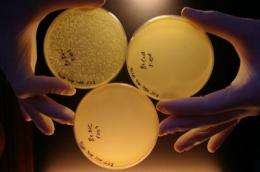Flu jab for bacteria

Viruses can wreak havoc on bacteria as well as humans and, just like us, bacteria have their own defence system in place, explains Professor John van der Oost, at the Society for General Microbiology's spring meeting. Uncovering the workings of the bacterial "immune system" could be used to keep industrial microbes at peak performance.
Professor van der Oost and his team at Wageningen University in the Netherlands have spent the last three years working out the molecular details of the immune system called CRISPR that is present in bacteria. The recently discovered CRISPR defence system differs from the immune system in higher organisms in that acquired immunity can be passed down future generations. This means bacterial offspring are protected from viral attack even before they are exposed to the invading virus.
Specific bacterial proteins recognise infectious viruses, called bacteriophages, by detecting foreign DNA. These proteins take the viral DNA and insert it into the bacterial genome at very specific locations. "Storing the information in this way gives the bacteria a lasting 'memory' of the harmful virus that subsequently confers immunity- much like our own immune systems," said Professor van der Oost. Upon future attack by the same virus, the DNA sequence of the invader is quickly recognised and destroyed by the bacteria.
Understanding the exact mechanisms of the CRISPR defence system could have big economic rewards for industry. "We can exploit this system and expose bacteria to artificial or modified bacteriophages whose DNA could be stored. This would be exactly like giving them a flu jab and protect them against a real attack in the future. For industrially-important bacteria this could be a great cost-saving method to reduce viral infections that may compromise yields of bacterial products. It's a classic example of vaccinating the workforce to increase its productivity."
Provided by Society for General Microbiology












